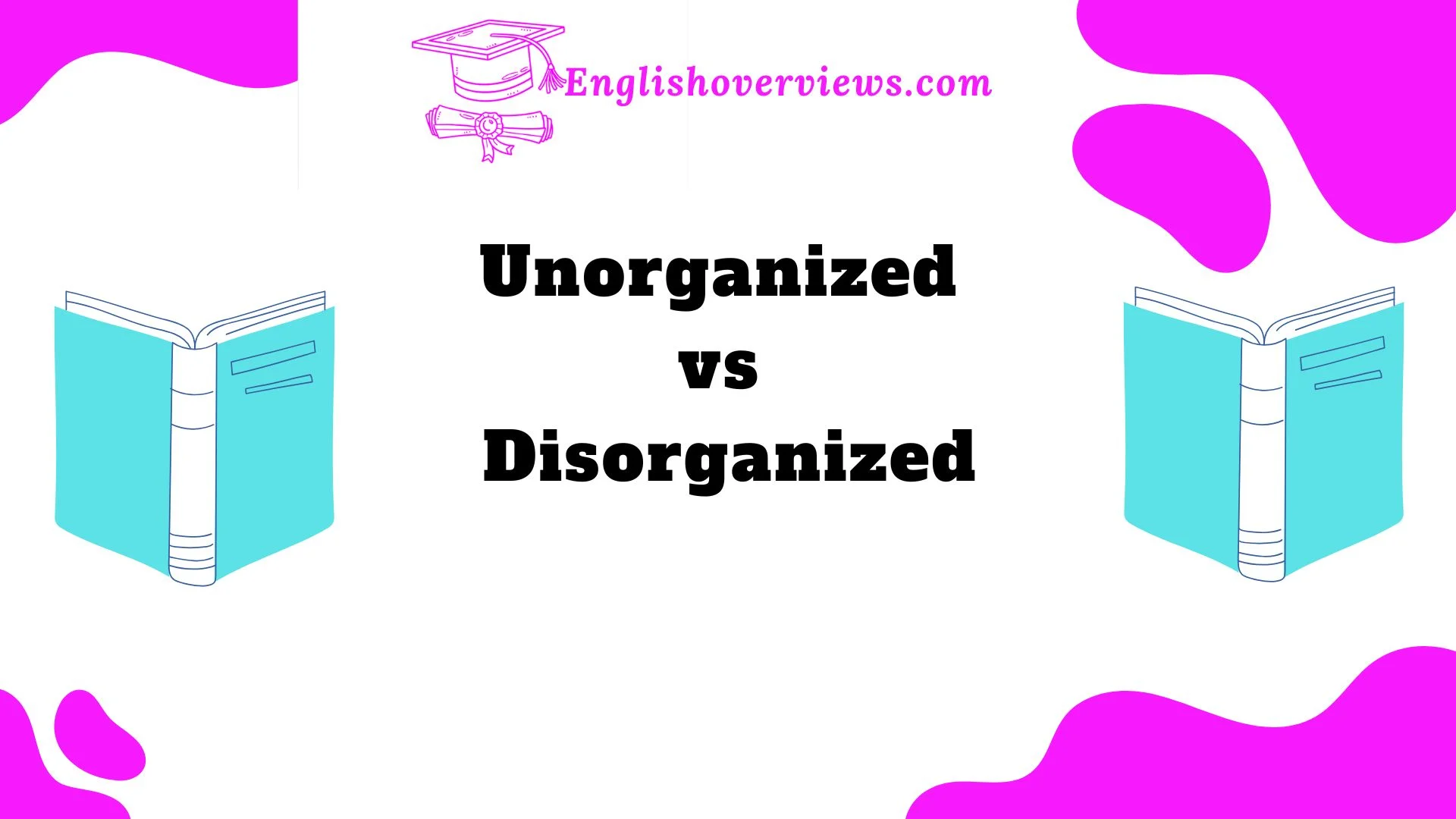At first glance, “unorganized” and “disorganized” may seem like two words that mean the same thing. However, when you dig a little deeper, you’ll discover that they carry distinct connotations, and choosing one over the other can have a significant impact on the message you’re trying to convey.
Understanding the subtle differences between these two terms will not only improve your communication skills but also help you sound more precise and articulate, especially in formal and professional settings.
Whether you’re drafting an email, writing a report, or simply engaging in casual conversation, choosing the right word matters. This article will explore the meaning of “unorganized” and “disorganized,” trace their origins, look at modern usage, and provide real-world examples to help clarify when to use each one.
Breaking Down the Prefixes: “Un-” vs. “Dis-“
To fully understand the difference between “unorganized” and “disorganized,” it’s important to break down the prefixes that give each word its meaning. Let’s start with the basics:
Un- Prefix: The Neutral Negation
The prefix “un-“ is often used to indicate the absence or lack of something. It’s a neutral term and tends to suggest a simple absence rather than an active process. For example:
- Unhappy – Lacking happiness.
- Unpredictable – Lacking predictability.
When you apply “un-“ to “organized,” it suggests that something has not been organized yet. The implication is neutral: it hasn’t been arranged, but there’s no inherent chaos or confusion. The absence of organization might be intentional, temporary, or just incomplete.
Examples of “Un-” Usage:
- The project remains unorganized because the team hasn’t had time to plan.
- His unorganized thoughts made it difficult to follow his argument.
Dis- Prefix: The Chaotic Disruption
On the other hand, the “dis-“ prefix often suggests more active disruption or negativity. When something is disorganized, it isn’t just lacking order—it’s actively in a state of disorder, confusion, or chaos. It implies that organization was once present but has been disturbed or destroyed in some way.
Examples of “Dis-” Usage:
- After the move, the house was disorganized, with boxes everywhere and no clear system.
- The meeting became disorganized when everyone started talking over each other.
Side-by-Side Comparison:
| Prefix | Definition | Examples | Tone/Connotation |
| Un- | Absence or lack of something | Unhappy, Unprepared | Neutral, not yet organized |
| Dis- | Disruption, disorder, confusion | Disrupt, Disarray | Negative, chaotic |
Etymology and Evolution: A Look Back at the Origins
Both “unorganized” and “disorganized” have roots in Old English, but their meanings and usage have evolved significantly over time. Understanding their historical journey helps us grasp why they carry the connotations they do today.
The Roots of “Unorganized” and “Disorganized”
- “Unorganized” is derived from the Old English word “un-“ (meaning “not”) combined with “organized” (which comes from the Latin “organum”, meaning “instrument” or “tool”). Thus, the term “unorganized” originally referred to something that was not yet arranged or structured.
- “Disorganized” comes from the Latin prefix “dis-“, meaning “apart” or “away,” paired with the same root word, “organized.” The term thus suggests that something was once organized but has since been disturbed or thrown into chaos.
Over the centuries, these words began to be used more frequently in everyday conversation, with “disorganized” eventually carrying a much stronger negative implication. “Unorganized,” on the other hand, remained more neutral, referring to something that just hadn’t been properly arranged yet.
Changes in Meaning Over Time
In the 19th century, “disorganized” began to carry connotations of confusion or disorder, as it was used in both personal and professional contexts. This was especially true in the context of business and military, where a lack of organization was often seen as a major flaw.
As the world became more structured and efficient, the term “disorganized” increasingly referred to a complete lack of structure or direction.
Understanding Modern Usage: Unorganized vs. Disorganized
Now that we’ve explored the historical origins, let’s take a look at how these words are used today. “Unorganized” is more neutral, while “disorganized” implies a deeper, more chaotic state of disorder.
“Unorganized” in Context:
When you describe something as unorganized, you are usually referring to the fact that organization hasn’t been established yet or that it is still in the process of being put together. The term implies a temporary state, not necessarily something that’s chaotic or problematic.
Examples:
- The unorganized pile of books will be sorted by the end of the week.
- Our plans are unorganized at the moment, but we’ll figure them out soon.
“Disorganized” in Context:
On the other hand, when something is disorganized, it suggests more than just an absence of order. It indicates a lack of coordination, possibly caused by mismanagement, distractions, or a failure to establish any form of structure. It’s usually associated with negative outcomes.
Examples:
- The office is disorganized after the move, and it’s hard to find anything.
- His disorganized approach to the project resulted in confusion and missed deadlines.
Comparison in Real-World Situations:
| Term | Definition | Example Sentences | Tone |
| Unorganized | Lacking organization or structure | “The files are unorganized right now, but they will be filed later.” | Neutral, temporary |
| Disorganized | In a state of confusion or chaos | “The files are disorganized, and it’s impossible to find what I need.” | Negative, chaotic |
The Subtle Nuances: When to Use Each Term
Context is Key: When to Use “Unorganized”
- Use “unorganized” when you want to convey that something hasn’t been organized yet, but the lack of organization is temporary and can easily be corrected.
- It’s also appropriate when discussing plans or situations that are still in the preparation phase.
When to Use “Disorganized”
- Use “disorganized” when describing situations that are actively chaotic or lack structure due to poor management or uncontrolled circumstances.
- It is often used to describe ongoing problems that require more than just a quick fix.
Quick Tips:
- Unorganized = Neutral or temporary lack of order.
- Disorganized = Chaotic or confused state of disorder.
Real-World Example:
Imagine a classroom where students haven’t yet received their seating assignments. You might describe it as unorganized. However, if students are scattering their belongings around the room without any regard for order, creating confusion and frustration, you would likely describe the situation as disorganized.
Final Thoughts: Key Takeaways
Understanding the difference between “unorganized” and “disorganized” is essential for more effective communication. Here’s a quick recap:
- Unorganized implies a lack of order or structure, but it’s a temporary state that can be corrected with effort.
- Disorganized suggests chaos or confusion, often due to poor management or oversight.
By choosing the right word for your context, you can convey your message more accurately and avoid any misunderstandings.
FAQs: Clearing Up Common Confusions
1. Is “unorganized” a word in English?
Yes, “unorganized” is a valid term in modern English, although “disorganized” is more commonly used when describing chaos or confusion.
2. Can “disorganized” be used as a positive term?
While “disorganized” generally carries negative connotations, there are instances where it can be used in a neutral or ironic way, such as in describing creative chaos or spontaneous work environments.
3. Are there other pairs of words like “unorganized” and “disorganized”?
Yes, other pairs of words with similar contrasts include “untidy” vs. “messy” and “incomplete” vs. “unfinished.”

English Overviews is a resourceful website dedicated to providing valuable content related to grammar and vocabulary. Muhammad Haroon has made notable contributions, sharing insights on various subjects, including WordPress themes and plugins. The primary goal of the site is to help users improve their English language skills effectively.











